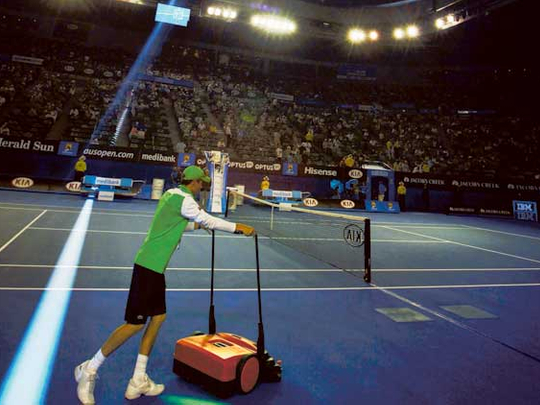
Melbourne: Was global warming a conspirator in causing Canadian player Frank Dancevic to hallucinate shortly before collapsing on court six?
As the Australian Open continues in Melbourne, so does the heatwave and the scorching temperatures of 41 degree Celsius and over.
Yesterday was the third day straight that the Olympic Park thermometer got above 41˚C. The forecast for Melbourne was a ball-dropping 44˚C.
But does human-caused climate change have anything at all to do with the water bottle-melting heat being endured by the players?
First for the usual caveats. Melbourne gets hot, and it has always experienced extremely hot days.
You can’t blame climate change entirely for hot weather, but you can say that it increases the risk of extreme hot weather events occurring. The planet’s atmosphere has been loaded with extra greenhouse gases, which gives the analogy of loading the weather dice to increase the chances of you rolling a six — or in this case, experiencing extremely hot days or seeing Snoopy.
Blair Trewin, a senior climatologist at the Bureau of Meteorology’s National Climate Centre, told me that over the long term, Melbourne experiences 1.3 days above 40˚C every year. But he says that between 2001 and 2013, the average across all those years was 1.9 days above 40˚C.
“Despite what people would have you believe, 40-degree days in Melbourne are not particularly common, and the city has gone as long as five years (1968 to 1973) without having any.”
When it comes to “single day extremes”, he says, there is a clear increase for the south east of the country, although it is much harder to see any trends in heatwaves.
Dr Sarah Perkins, researcher at the ARC Centre of Excellence for Climate System Science at the University of New South Wales, specialising in studying heatwaves believes in human-caused climate change.
“In Melbourne we are seeing an increase in the amount of extreme heat — there’s a disproportionate change when compared to the 1C increase we’ve seen in the average temperature for Australia.
“We are also seeing an increase in heatwaves not just in Melbourne, but across Australia.
“Of course, summer is naturally hot and extreme temperature events will occur at this time of year. But we’re now seeing much more of these events, that last longer, and are hotter. It’s this trend that’s concerning.
“Because of the background warming that’s already there, there is a greater risk now of us seeing these events happen so in that respect, it’s game, set and match.
Her studies have shown that since 1980, Melbourne is now experiencing an average of between one and two extra “heatwave days” every year. A heatwave day is a day that can contribute to a string of hot days.
While an extra day or two doesn’t sound like much, Perkins says the average heatwave days per year before 1980 was only between five and six.
Perkins also says there are generally three natural climate phenomena related to extreme heat in the south east of the country.
None of these three “modes”- El Nino, the Indian Ocean Dipole and the Southern Annular Mode — were currently in cycles associated with higher extreme temperatures, says Perkins.
Perkins has also created a website — scorcher.com.au — which tracks heatwaves across Australia almost as they happen (there’s a two-day lag time).
The Bureau of Meteorology has also launched a pilot heatwave service to forecast extreme conditions and help the community, including health agencies, prepare.
As for the future, it seems likely that the chances of more heat during the Australian Open are on the rise. A report from the independent Climate Council says in the future, the number of heatwaves in Australia will “increase significantly”.












